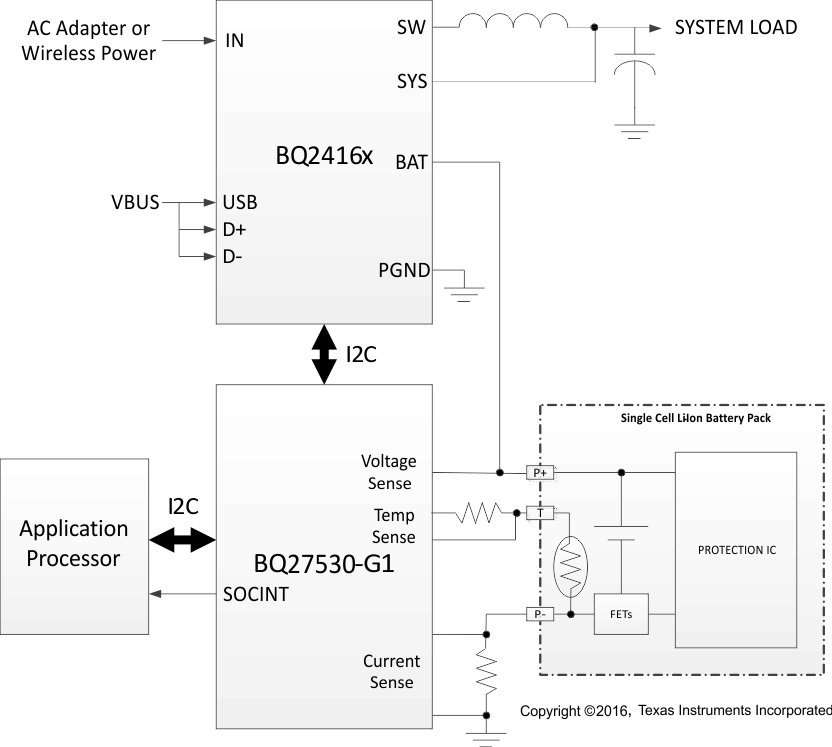ZHCS240C December 2012 – June 2016 BQ27530-G1
PRODUCTION DATA.
- 1 特性
- 2 应用
- 3 说明
- 4 修订历史记录
- 5 Pin Configuration and Functions
-
6 Specifications
- 6.1 Absolute Maximum Ratings
- 6.2 ESD Ratings
- 6.3 Thermal Information
- 6.4 Recommended Operating Conditions
- 6.5 Supply Current
- 6.6 Digital Input and Output DC Characteristics
- 6.7 Power-on Reset
- 6.8 2.5-V LDO Regulator
- 6.9 Internal Clock Oscillators
- 6.10 ADC (Temperature and Cell Measurement) Characteristics
- 6.11 Integrating ADC (Coulomb Counter) Characteristics
- 6.12 Data Flash Memory Characteristics
- 6.13 I2C-Compatible Interface Communication Timing Characteristics
- 6.14 Typical Characteristics
- 7 Detailed Description
- 8 Application and Implementation
- 9 Power Supply Recommendations
- 10Layout
- 11器件和文档支持
- 12机械、封装和可订购信息
1 特性
- 适用于 1 节锂离子电池应用的电池电量监测计和充电器 控制器
- 驻留在系统主板上
- 基于已获专利的 Impedance Track™技术的电池电量监测计
- 可为准确续航时间预测建模电池放电曲线
- 可针对电池老化、电池自放电以及温度/速率低效情况进行自动调节
- 低值感应电阻器(5mΩ 至 20mΩ)
- 具有可定制充电曲线的电池充电器控制器
- 基于温度的可配置充电电压和电流
- 可选运行状况 (SOH) 和多级充电曲线
- 无主机自主电池管理系统
- 减少了软件开销,提升了各平台间的可移植性同时缩短了 OEM 设计周期
- 提高了安全性
- 改善了运行时间
- 借助 Impedance Track 技术延长电池运行时间
- 能够对充电器终端进行更严格的精度控制
- 改进的再充电阈值
- 智能充电 - 定制的自适应充电曲线
- 基于 SOH 的充电器控制
- 温度水平充电 (TLC)
- 针对 bq2416x 单节开关模式电池充电器的电池充电器控制
- 独立充电解决方案
- 400kHz I2C™用于与系统微处理器端口相连接的接口
- 采用 15 引脚 NanoFree™封装
2 应用
- 智能手机、功能型手机和平板电脑
- 数码相机与视频摄像机
- 手持式终端
- MP3 或多媒体播放器
3 说明
德州仪器 (TI) 的 bq27530-G1 系统侧锂离子电池管理单元是一款微控制器外设,可提供针对单节锂离子电池组的 Impedance Track™ 电量监测和充电控制。此器件只需很少的系统微控制器固件开发。与 bq2416x 单节开关模式充电器搭配使用,bq27530-G1 可管理一个嵌入式电池(不可拆卸)或一个可拆卸电池组。
bq27530-G1 使用获得专利的 Impedance Track™ 算法来进行电量监测,可提供剩余电池电量 (mAh)、充电状态 (%)、续航时间(分钟)、电池电压 (mV)、温度 (°C) 和运行状况 (%) 等信息。
器件信息(1)
| 器件型号 | 封装 | 封装尺寸(标称值) |
|---|---|---|
| bq27530-G1 | DSBGA (15) | 2.61mm x 1.96mm |
- 如需了解所有可用封装,请参阅数据表末尾的可订购产品附录。
简化电路原理图
